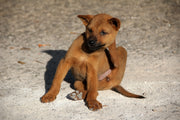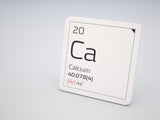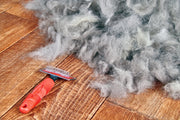What Should My Dog's Poop Look Like?
It’s a reality of responsible pet owners that every day you pick up dog waste. That makes you a good dog-owning citizen, but it’s also an opportunity to pay attention to how well your dog’s insides are functioning based on what your dog produces.
The following blog post will give you an idea of what the ideal dog poop should look like.
Generally, if your dog has an off day and has a bowel movement that’s a little softer or harder, lighter or darker than average there’s nothing to worry about. But if the poop stays outside the normal range for more than a couple of days, or if the change in poop is accompanied by fever, lethargy, lack of appetite, or any other signs that your dog is not well, then don’t delay and head into the vet’s office to see what’s causing the problem.
The Colour of Dog Poop Tells A Story
Healthy dog poop should be chocolate brown. Other colours indicate problems somewhere along the digestive tract. Green poop could mean there’s a problem with the gallbladder or that your dog isn’t digesting fats very well.
Black Dog Poop can mean your dog is bleeding high up in the digestive system.
Liver disease or a problem with the pancreas or gallbladder can result in yellow or grey-tinged poop.
Red streaky dog poop is likely caused by bleeding lower down in the digestive tract and white spots could mean your dog has worms.
White chalky dog poop or white stools could mean that your dog is getting too much calcium or bone in the diet. This is why it’s really important that your raw dog food diet is properly balanced and not too high in calcium.
What is Normal Dog Poop Consistency?
Many vets use a stool consistency scale when examining dog faeces. A score of 1 indicates very hard stool that may look like pellets or small stones. At the other end of the scale, a score of 7 would mean your dog’s poop basically looks like a puddle. The ideal is about a 2 or 3, firm but can be squished if you were to press it.
Hard stool samples that look and feel like pebbles or straining without passing any poop at all can mean that your dog is constipated. Too much insoluble fibre or not enough water can both cause problems, but so can swallowing hair. Some dogs over-groom, licking their fur so much they wind up swallowing hair that creates a blockage.
Hard obstructions, like those caused by swallowing something the dog can’t pass (ball, rock, socks, feminine hygiene products fished out of the bathroom garbage receptacle - sorry, that’s graphic, but it does happen) can lead to a life-threatening situation. Don’t wait if your dog hasn’t pooped for more than a day or two. Call your vet and investigate.
Diarrhoea or loose stools may occur after your dog picks up something he shouldn’t and eats it. The body naturally wants to pass whatever it is quickly, so you may notice a day or so of softer-than-normal poops. If the diarrhoea continues, though, that can be a sign of a more serious health problem. Some causes of diarrhoea in dogs include food allergies, digestive tract infections, parasites, or even inflammatory bowel disease. Extremely watery poop can quickly cause dehydration, especially in puppies, and should not be ignored.

Volume - How Much Dog Poop is Normal?
Because processed kibble can contain large amounts of indigestible filler like beet pulp, peas, grains, or other added cellulose, dogs on a commercial dry diet tend to produce more poop. Dogs are designed to eat meat, so any significant amount of other material basically passes straight through the digestive system.
If your dog has recently switched to a raw food diet you may notice the volume of your dog’s stool decreases. That’s normal and a good sign. Dogs are able to use the nutrients in a properly formulated raw food diet much better than a commercial kibble diet, so their poop is generally firmer and smells less pungent. Often, kibble poop smells terrible because of all the undigested material it contains.
Other Poop Indicators
Other indicators of how well your dog’s innards are working include the presence of an excessive amount of mucous coating the poop. Some slime occasionally coating your dog’s poop is not necessarily a cause for concern, but a lot on an ongoing basis could indicate food allergies or inflammation of the lower intestines.
Don’t Forget the Poop Sample
Because a dog’s poop is such a rich source of information about your dog’s health, it’s helpful to take a sample to the vet. Collect a fresh sample in a plastic sandwich bag and, of course, wash your hands well every time you pick up your dog’s poop, whether you are collecting a sample for the vet or just being a responsible dog owner.
Keep in mind that changing your dog’s diet can (logically) also result in a change in their poop. It’s a good idea to handle major dietary changes gradually to give your pup a chance to adjust. We’ve noticed that dogs on a Rawmate raw food diet tend to adapt very well, producing healthy chocolate-brown poop that’s not too runny and not too dry.
Cleaning up after your dog shouldn’t be a difficult task. If you are struggling to get your pets waste into a plastic bag then nutrition and overall health should be the first place you look. Chronic constipation is NOT normal and if you observe this in your pet for more than 24 hours, you should seek veterinary advice.
There’s less of excrement than dog and cats fed commercial kibble, and it doesn’t smell as bad. All of that is good news because it means the dog’s diet is well-matched to the dog’s natural digestion needs. Which is exactly why we do what we do!







There are 0 Comments